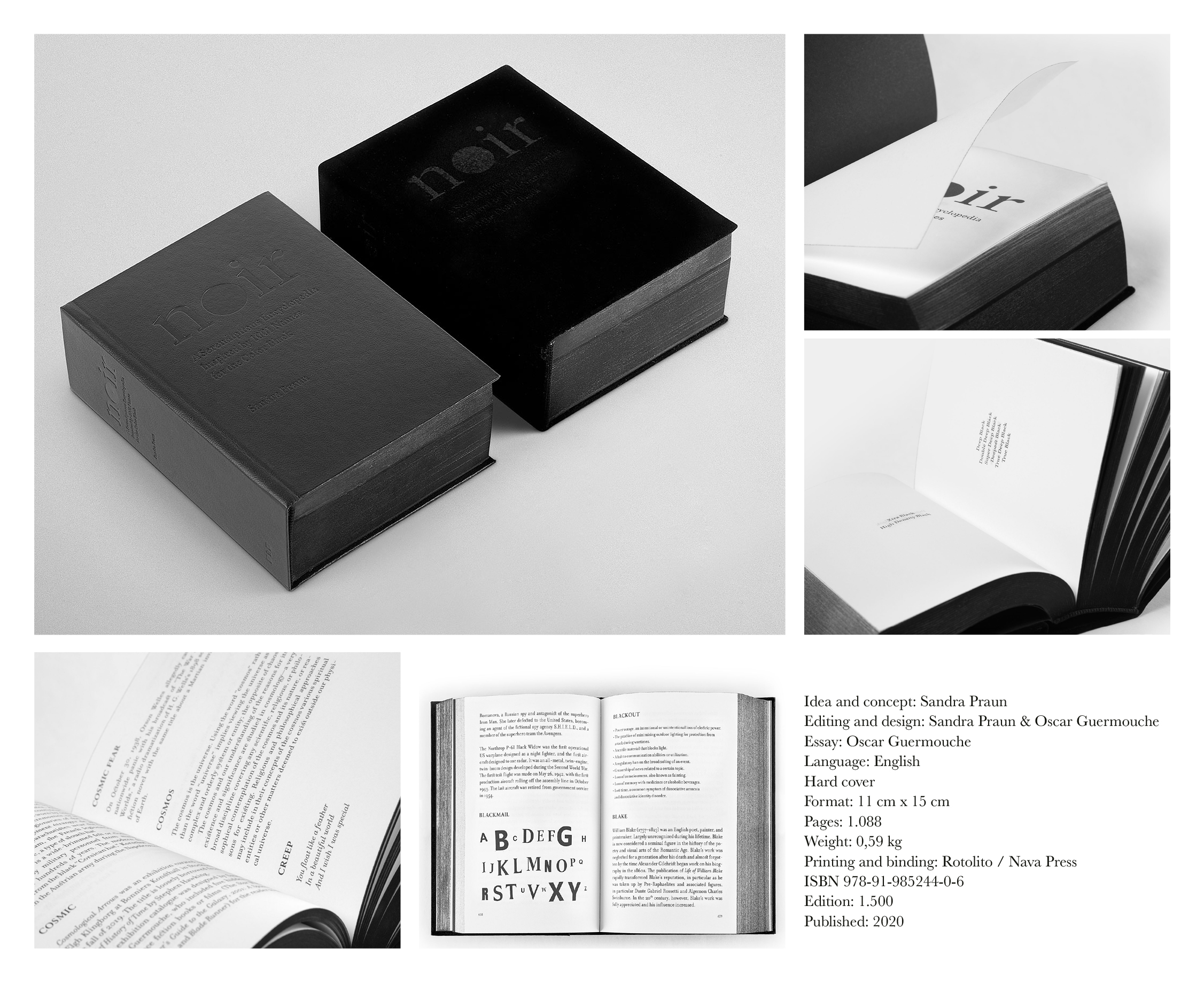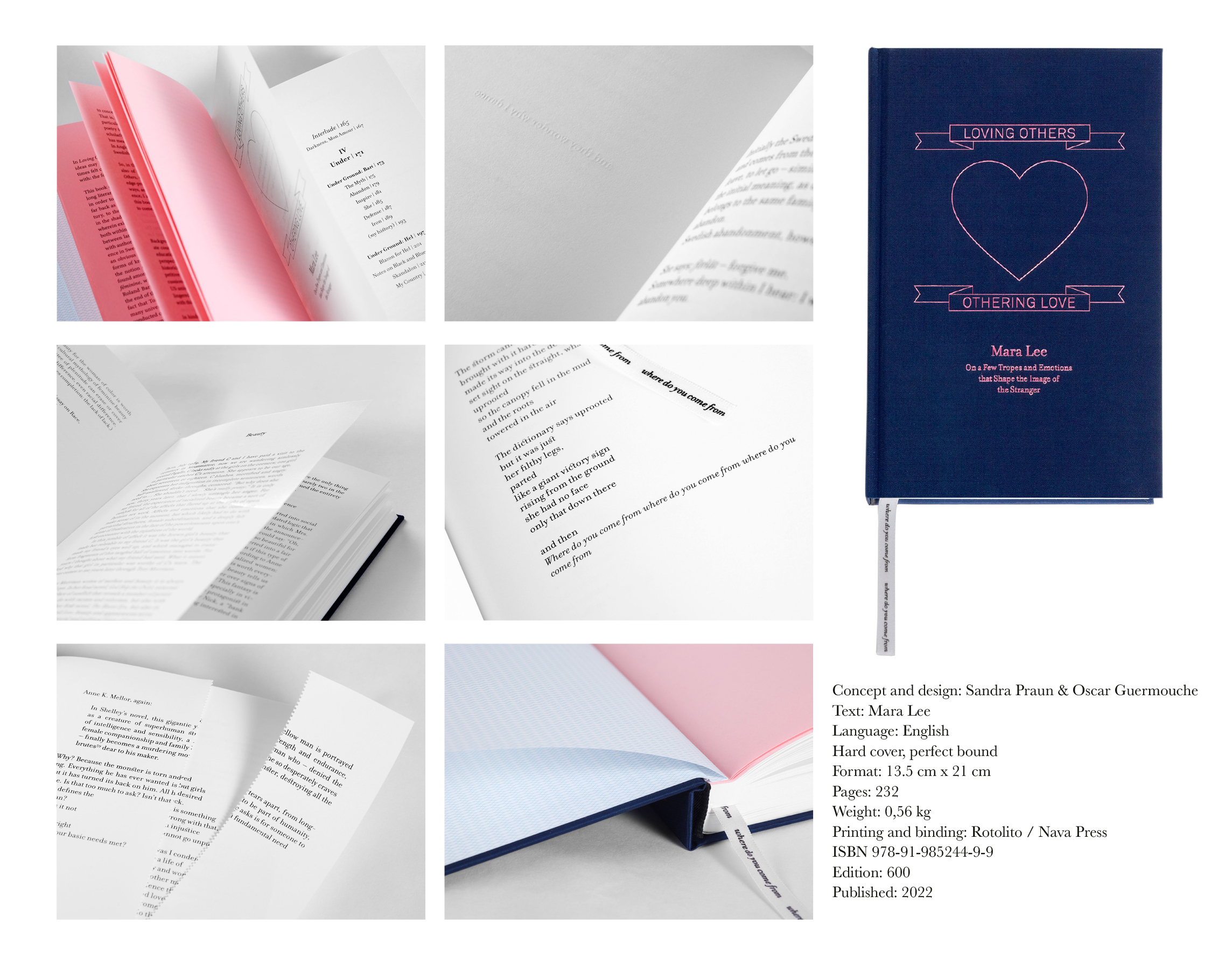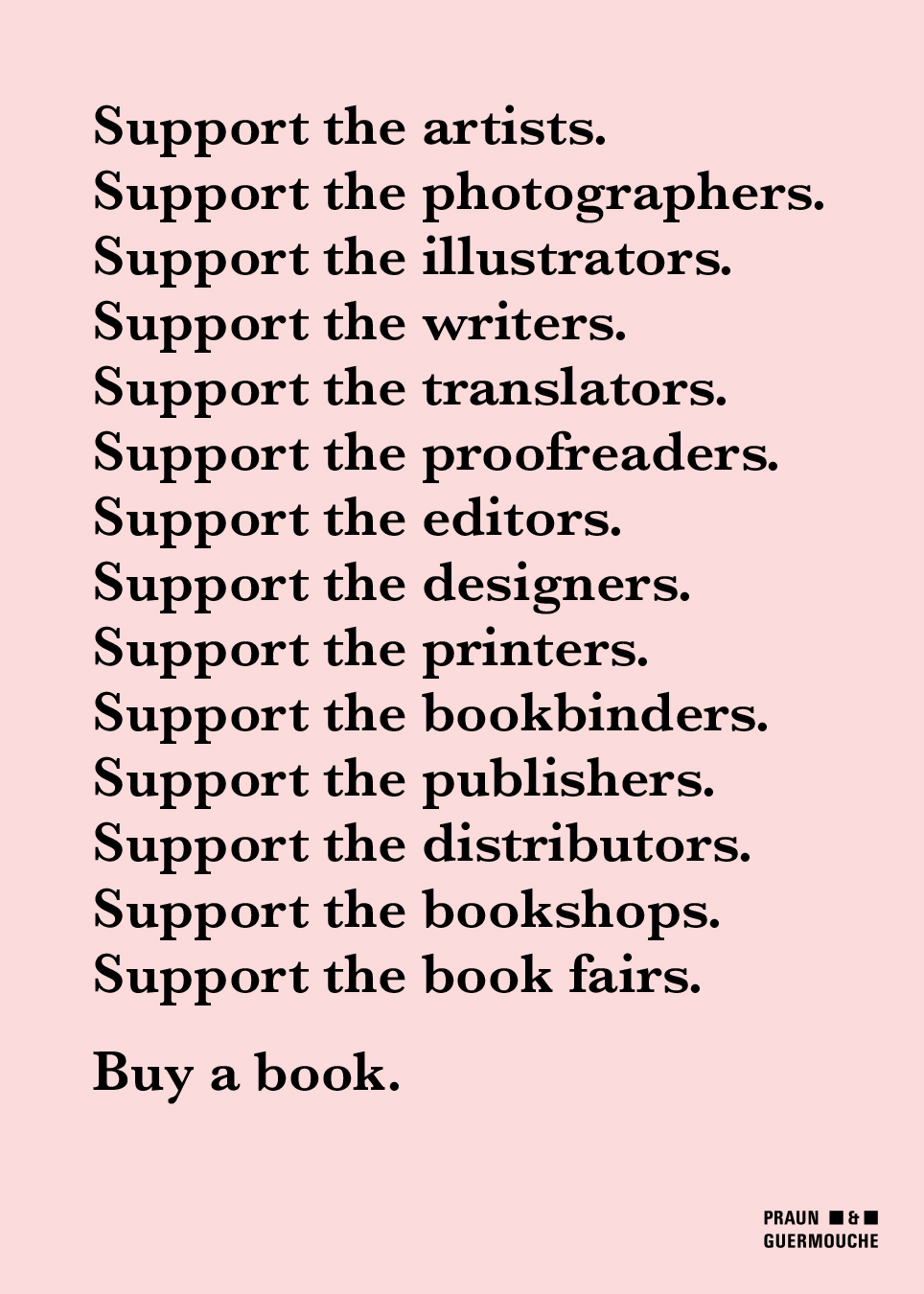Praun & Guermouche
We believe that the way books convey art has intrinsic value, and accordingly the books we produce should both reflect and complement the art. This means that we not only design books based on their contents, but that we also shape the contents in accordance with the book. For the works to come into their own, they need to be translated into the materiality, spatiality, and narrativity of the book. It’s a matter of creating a space in which the art can communicate in other ways than in documentation, in an exhibition, or even in the works themselves. In our practice we use the possibilities and limitations of the bound book as our starting point.

In Noir – A Serendipitous Encyclopedia Inspired by 1001 Names for the Color Black graphic designer Sandra Praun takes on the color black and the language that charges it with a variety of characteristics. The book consists of three parts:
The first comprises 1,001 names for different nuances of black, taken from, for example, make-up, car paint, artist pigments, tattoo ink, and house paint. The often expressive names have been collated into an associative flow that transports the reader from countries and cities, over mountains and oceans, down among plants and animals, out into space, to myths and religions, power and eroticism, war and death.
The second part is a lexicon using a selection of the names as its point of departure. The contents of the articles are based on a variety of materials, collected with a serendipitous method. The name that a manufacturer has chosen for its black shade becomes a growing network of tributaries connecting to the world. Following the different branches leads to vastly different contexts such as pop music, contemporary art, sports, poetry, film, dictionaries, political speeches, and scientific articles. One or other autobiographical detail has been scattered among the articles. The different sources, perspectives, and media give a multifaceted impression of the connotative and associative capacity of the color.
In the third part, the 1,001 names are listed in alphabetical order along with their product category and manufacturer. A marker indicates whether the name is included in the lexicon or not.
The book includes an essay by artist Oscar Guermouche. The text debates the word “black” and what it means to the objects, phenomena, and people it is ascribed to.

Loving Others, Othering Love – On a Few Tropes and Emotions that Shape the Image of the Stranger is a multi-modal lyric essay that investigates the interdependence of love and racism. It is a text that mines the multitude of ways that each requires the other in efforts to normalize or mask white privilege. Here, Lee marshals her analyses out of such material as Swedish newspaper reporting on racist hate crimes, Mary Shelley’s Frankenstein, Princess Bari, Ovid, and the manifesto of mass shooter Elliot Rodger. Startling in its elegant incisions into the literary, the popular, the public, and the mythological, Loving Others, Othering Love enacts a critical poetics of assemblage in order to reveal the racist duplicity of love.
Mara Lee is one of Sweden’s most prominent contemporary writers, as well as a translator and scholar. She is the author of several novels and volumes of poetry, including the internationally recognized Ladies from 2007 and award winning Love and Hate from 2018. Lee’s work mobilizes the paradoxes and confluences that emerge when the physical and linguistic realities of sexuality, gender, and race manifest themselves against the backdrop of Swedish welfare state whiteness, its quotidian power and purported racelessness. She is professor of art, art theory, and art history at Konstfack University of Arts, Crafts and Design, and guest professor at the Royal Institute of Art in Stockholm.
The Diplomatic blue cover of the book with the debossed metallic emblem that dominates the front, together with the pattern of the endpapers, alludes to the passport. The passport is the traveler’s document, the stranger’s. It marks nationality and citizenship, but not belonging, not where one actually comes from – belonging is perceived to be situated in the body, in the blood, in the color of the skin. In turn, the debossed emblem, a heart with two banners, brings to mind the tattoo – a mark on the skin, a stigma, but also history, memory, dedication. The heart follows into the book, marking the translator’s comments in the footnotes. The preface is printed on pink pages. The symbol-laden color signals girlhood, the sweet, the virgin, while carrying a history of power and struggle and feminism. The first page of the chapter “Beauty” is partly covered by a shimmering surface in mother-of-pearl; the phrase “and they wonder why I dance” in “Inspiro” is debossed, sort of stamped down into the page, which gives an echo on the other side; in “Monstrum” a punched line extends along an entire page, straight through the sentence “Because the monster is torn and tears apart, from longing.” A repetition of a phrase in the chapter “Under Ground: Whole” runs on the ribbon bookmark: Where do you come from where do you come from where do you come from.

The Informal Monument is a compilation of material from photographer-duo Willner-Olsson’s long-standing project on heaps. Heaps are an ever-present phenomenon in the history of humankind—burial mounds, trash piles, heaps of leaves, snow, fertilizer. Often a humble, peripheral aspect in both rural and urban landscapes, it is a bearer of stories at the intersection of nature and culture.
Each of the 81 selected photographs from Willner-Olsson’s documentation of heaps has its own dedicated spread, encouraging individual contemplation. The Informal Monument further encompasses the duo’s investigative work, relating both to the inherent connotations of the heap, represented in the book in the form of an associative article system, and to its physical characteristics, studied through experimental sessions conducted outdoors and in the studio environment. The book includes the introductory essay “Of a Port in Air” by writer and critic Brian Dillon.
The duo Willner-Olsson consists of the photographers Johan Willner and Peo Olsson. They have been working together on projects around landscape and the changes within it since 2015. Both attended the International Center of Photography in New York in the mid-1990s and subsequently graduated with an MFA, Olsson from the School of Photography at the University of Gothenburg and Willner from Konstfack—University of Arts, Crafts and Design.
Brian Dillon is an Irish writer and critic based in London. His books include Affinities, Suppose a Sentence, Essayism, and In the Dark Room. His writing has appeared in The Guardian, The New York Times, London Review of Books, The Times Literary Supplement, Bookforum, frieze, and Artforum. He is also the UK editor of Cabinet Magazine.

Poster 50 cm x 70 cm (also available in black on white and white on black)
[+]




